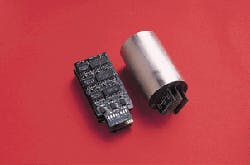U.S. Air Force munitions researchers needed a solid-state data recorder able to withstand crippling shock forces of as much as 100,000 Gs. That is in the range of a high-velocity missile, bomb, or artillery shell as it smashes through several feet of reinforced concrete.
They found their solution with the CM343 Solid State Recorder from Controlex Corp. of Van Nuys, Calif. Controlex engineers worked with Air Force munitions test specialists to immobilize the recorder and special data connectors inside a steel cylinder that literally can be shot out of a cannon and survive the impact.
Air Force leaders are using the Controlex recorder in a project to perfect a special "bunker-busting" bomb that detonates only after penetrating the walls or roofs of hardened targets such as command-and-control sites or other heavily reinforced military structures.
The recorder is crucial for a series of experiments to develop a fuze that can sense voids, or empty spaces, between planes of concrete that might indicate the actual locations of valuable targets such as military leaders or command, control, and surveillance equipment.
"The bombs we dropped at the end of Desert Storm we wanted to go into the shelter and then detonate," explains Aaron Brinson, technical director of the U.S. Air Force Research Laboratory Munitions Directorate`s ordnance division at Eglin Air Force Base, Fla. "We are trying to develop fuzes that will detect those voids as it goes through hardened targets. We do subscale tests, take a penetrator, and shoot it out of a 6-inch gun. That data helps us develop the technology for the fuze."
The recorder stores test information in two recorder packages, one that records analog data from accelerometers, and another that measures what the fuze is calculating, Brinson explains.
The overriding issue that researchers face is recovering the data from the penetrator after test firings. "Our recorder is inside the penetrator," points out Marcelious Willis, the Air Force program manager for the Controlex recorder at Eglin. "We typically see anything from 30,000 to 100,000 Gs."
Not only must the recorder survive the impact, but it also must "keep the data after it hits, because it may be a while before we can get it," Willis says. "It may take us days or weeks to dig it up."
To solve the problem of holding data, Controlex designers use commercial off-the-shelf (COTS) Flash solid-state memory. Other kinds of solid-state memory, such as battery-backed SRAM or DRAM, might have been able to survive the shock, but the time it takes to dig up the projectile can exhaust the battery.
The real design challenge for the solid-state recorder, however, is surviving the shock of the cannon shot. "We had some guidance from the fuze folks at Eglin for the packaging, says Controlex President Bruce Kaufman.
"The integrated circuits are actually plastic-molded COTS ICs. They are surface-mount on high-density multi-layer boards, which are 2.3 inches long and 2.3 inches wide," Kaufman says. "They are interconnected and slipped inside the steel shell that provides integrity for the entire package. They are not cushioned. They are potted, or encapsulated, in a special epoxy that locks everything in place. There is no cavity void inside the package, so nothing moves. The idea is to make this one big block, because if something moved it would tear wire bonds and shear off parts."
To download the test information from the recorder, technicians connect cables to special connectors at the edges of the boards that are accessible after they remove the recorder from the steel cylinder.
For more information, contact Kaufman at Controlex by phone at 818-780-8877, or by post at 16005 Sherman Way, Van Nuys, Calif. 91406. — J.K.
The CM343 Solid State Recorder from Controlex can survive shock of 100,00 Gs.

